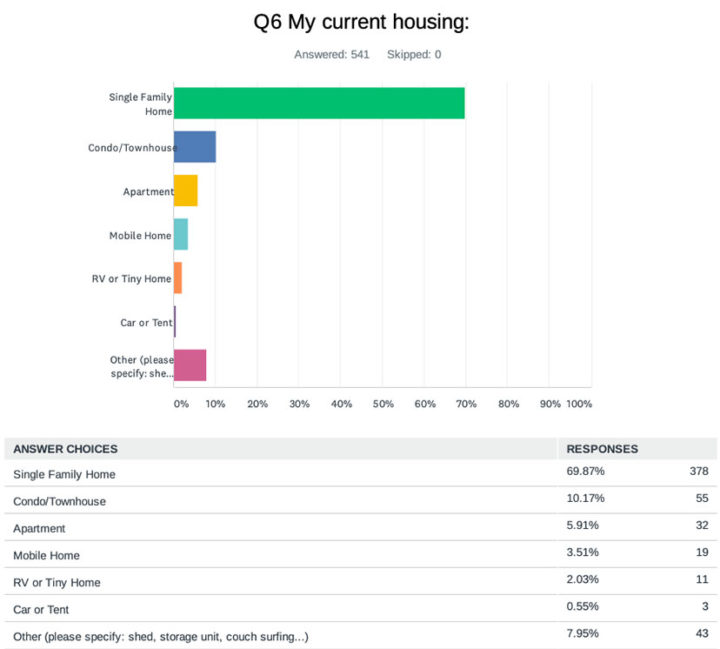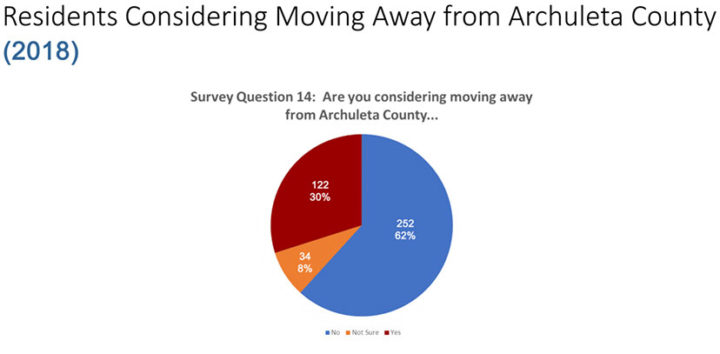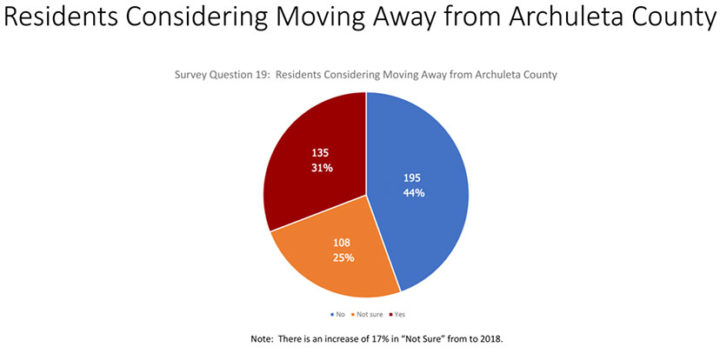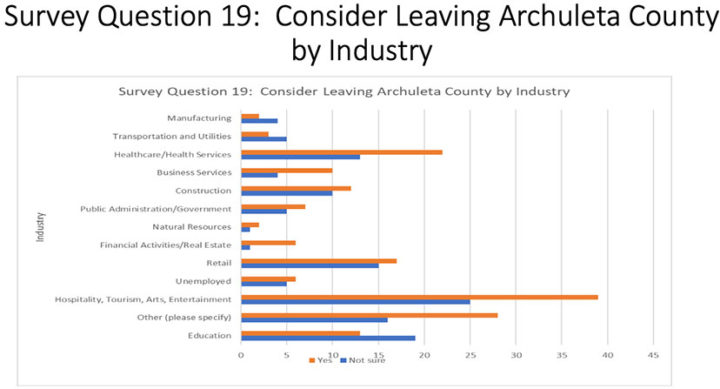A friend of mine had to laugh, when he heard about the proposed conversion of the Pagosa Springs Inn & Suites motel into 98 residential apartment units.
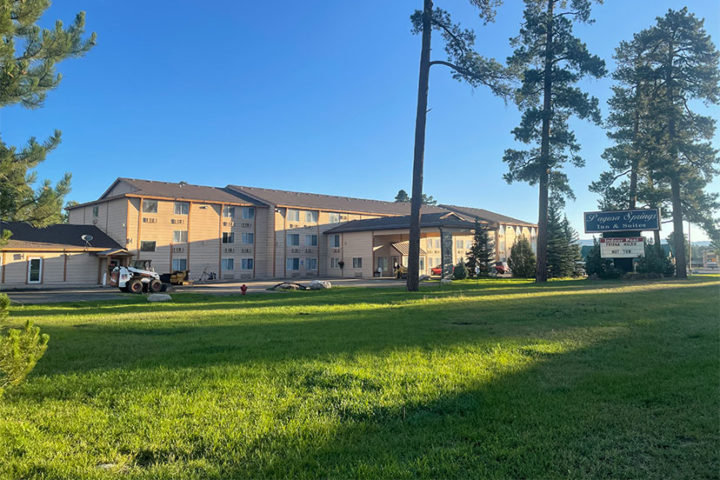
“What a strange world we’re creating here in Pagosa Springs,” he suggested. “Our tourists are occupying the single family houses and townhomes… and our workforce is relegated to living in motel rooms.”
Funny. But not funny.
I mentioned, back in Part Five, that, far from being a healing force in the community, ‘the free market’ — which is, the real estate market, the housing market — has been doing exactly the opposite of healing our neighborhoods. The ‘market’ has been driving out people who once lived in Pagosa Springs, and replacing them with temporary visitors.
But ‘the market’ doesn’t exist in a vacuum. We are all part of ‘the market’. Especially, perhaps, those of us who are most concerned about the future of Pagosa Springs, can play a role in re-directing ‘the market’ — and we have various tools at our disposal, to be used for better or worse.
And the “free market’ in housing is, in fact, anything but free. Our local governments have put housing in a sort of minimum-security prison, from which escape hardly seems possible. More about that in Part Eight, tomorrow.
I’m thinking, now, about the conversation we had during the bimonthly meeting of the Pagosa Springs Housing Coalition, last week. We were discussing the survey results from Pagosa Housing Partner’s 2021 Residential Housing Survey, and the conversation focused, for a few minutes, on the expressed preference of most of survey respondents to live in a single family home. The survey had asked respondents to indicate what type of housing seemed most attractive to them: a single-family home, a condo or townhome, an apartment, a place to park an RV or Tiny House, and so on. The overwhelming top pick, ‘single-family home’, was no surprise, with about 2-out-of-3 respondents choosing that option as their preferred choice. (As shown by the light blue color, below)
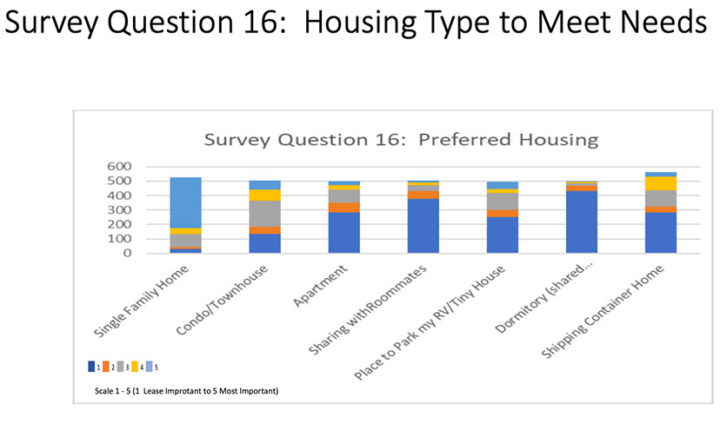 Sometimes, when we analyze surveys, however, we look only at what’s most obvious, and we miss important details.
Sometimes, when we analyze surveys, however, we look only at what’s most obvious, and we miss important details.
Since the 1940s, US families have typically seen single-family-home-ownership as a central element of the American Dream, and as we discussed the topic of single-family homes at the Housing Coalition meeting, the same assumption seemed to be dominating the conversation: that every family and individual wants a single-family home… and that condos and townhomes and apartments and the rest are something no one really wants to live in, given a choice.
But if we look closely at the responses to the 2021 Residential Housing Survey, we see that, in fact, about one-third of the respondents did not pick ‘single-family home’ has their preferred housing option. About 10% of the responded said they preferred a condo or townhome. Another 10% picked “Place to Park my RV/Tiny Home”.
And about 5% of the respondents picked “Shipping Container Home” as their top choice. Fully 100 respondents picked “Shipping Container Home” as their second-best choice (shown by the yellow color), making that option the most popular, as a ‘second choice’.

Unfortunately, in 2021, very little housing of any kind is readily available, if you are trying find a place to live in Pagosa Springs… unless you are a tourist willing to pay vacation-rental rates.
The majority of the survey respondents did have current housing, and most — about 70% — were living in a single-family home. This makes sense, because the lion’s share of residential dwellings built in Archuleta County since the 1880s are single family homes.
(This particular graph includes retirees, who were excluded from PHP’s deeper analysis into ‘workforce housing’. About 20% of the survey respondents in 2021 listed themselves as ‘retired’.)
About 10% of the respondents were living in an RV, Tiny Home, Car, Tent… or ‘Other’. What does ‘Other’ mean, for the 8% who picked that option?
‘Depends’
‘Homeless on August 1’
‘Barn’
‘Staying with family until housing available’
‘Still living in ex’s house because I can’t find a place’
‘Vacation rental, in need of long term rental’
‘Apartment 1.5 hours away’
‘In laws’
‘Renting a room’
‘Couch surfing’
‘Yurt’
‘Living in my friend’s living room’
‘Back room of the restaurant where my partner works, with the owner’s permission’
‘I live in a single family home but my lease ends in 8 days…’
… and so on… 43 uncomfortable situations. Add in the folks living in RVs, ‘Tiny Homes’, cars and tents, and we heard from 57 respondents who have chosen ‘non-traditional’ living situations. Or else, had no choice.
When housing options are limited, there is always the option of moving away. (But… where would you go?)
When the 2018 survey respondents were asked if they were considering moving away from Archuleta County, about 64% — about two-thirds — said they were not thinking in that direction. (The blue slice of pie in the chart below.)
Three years later, the percentage of respondents who were definitely thinking about leaving (red), or who were not sure (orange), was approaching 60%.
The 2021 survey also asked respondents (the ones who were thinking about leaving) to give a reason why they were unhappy. The dominant reason given was “Pets not allowed.” And of the people who picked that option, almost half chose it as “Most Important” (light blue).
A smaller number of people picked “Lack of housing I can afford” — but among that group, about 8-out-of-10 picked it as the “Most Important” reason.
The economic sectors most represented among the workers who were considering leaving Archuleta County were, in order of numbers of employees: the hospitality/tourism industry; the healthcare/health services industry; the education industry; the retail industry. (And ‘Other’).
It’s a fine thing, to conduct a survey and collect some data. But it’s a meaningless exercise, unless our community leaders use that data to lead us into a better situation.
What has happened, to create a situation where tourists are able to stay here comfortably, but incoming working families and individuals have no housing options available? We’ve talked a little bit about ‘zoning’ in relation to the proposed conversion of the Pagosa Springs Inn & Suites into a 98-unit apartment building.
Read Part Eight…


